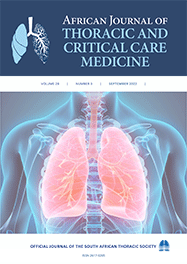Original research

Prediction of peak expiratory flow rate in a Ugandan population
Abstract
Background. Peak expiratory ow rate (PEFR) measurement is one of the commonly used methods for assessing lung function in general practice
consultations. e reference values for use by this method are mainly from Caucasian populations; data for African populations are limited. e
existence of ethnic and racial dierences in lung function necessitates further generation of PEFR reference values for use in African populations.
Objective. To generate equations for predicting PEFR in a Ugandan population.
Methods. e PEFR study was cross-sectional and based in rural south-western Uganda. Participants were aged 15 years or more, without respiratory
symptoms and were residents of the study area. Multiple regression equations for predicting PEFR were tted separately for males and females. e
model used for PEFR prediction was: logePEFR = intercept + a(age, y) + b(logeage) + c(1/height in cm), where a, b and c are the regression coecients.
Results. e eligible study population consisted of 774 males and 781 females. Median height was 164 cm (males) and 155 cm (females).
e majority of participants had never smoked (males 76.7%; females 98.3%). e equation which gave the best t for males was
logePEFR = 6.188 – 0.019age + 0.557logeage – 199.945/height and for females: logePEFR = 5.948 – 0.014 age + 0.317logeage – 85.147/height.
Conclusion. e curvilinear model obtained takes into consideration the changing trends of PEFR with increasing age from adolescence
to old age. It provides PEFR prediction equations that can be applied in East African populations.
Authors' affiliations
Susan Kiwanuka Nakubulwa, Medical Research Council/Uganda Research Unit on AIDS, Entebbe, Uganda
K Baisley, London School of Hygiene and Tropical Medicine, London, UK
J Levin, School of Public Health, Faculty of Health Sciences, University of the Witwatersrand, Johannesburg, South Africa
Full Text:
Cite this article
Article History
Date published: 2015-12-04
Article Views
Full text views: 484
Refbacks
- There are currently no refbacks.
African Journal of Thoracic and Critical Care Medicine| Online ISSN: 2617-0205
This journal is protected by a Creative Commons Attribution - NonCommercial Works License (CC BY-NC 4.0) | Read our privacy policy.
Our Journals: South African Medical Journal | African Journal of Health Professions Education | South African Journal of Bioethics and Law | South African Journal of Child Health | Southern African Journal of Critical Care | African Journal of Thoracic and Critical Care Medicine| South African Journal of Obstetrics and Gynaecology |



.jpg)